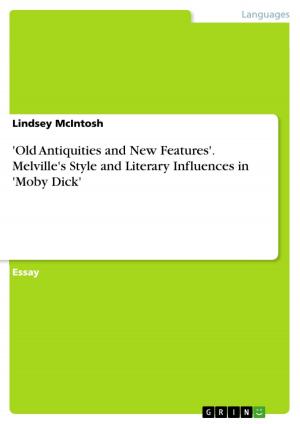Loneliness and Isolation in a Troubled Community: Winesburg, Ohio
Nonfiction, Entertainment, Drama, Anthologies| Author: | Nils Hübinger | ISBN: | 9783656420378 |
| Publisher: | GRIN Verlag | Publication: | April 26, 2013 |
| Imprint: | GRIN Verlag | Language: | English |
| Author: | Nils Hübinger |
| ISBN: | 9783656420378 |
| Publisher: | GRIN Verlag |
| Publication: | April 26, 2013 |
| Imprint: | GRIN Verlag |
| Language: | English |
Seminar paper from the year 2012 in the subject American Studies - Literature, grade: 13, Justus-Liebig-University Giessen (Anglistik), course: Seminar: Short Story Cycles, language: English, abstract: The 1919 short story cycle Winesburg, Ohio, written by the American author Sherwood Anderson, deals with an imaginary American Midwestern small town named after its title and tells the stories of its odd citizens. Each of the 22 stories is concerned with another character and his or her troublesome life in Winesburg. The book's prologue (The Book of the Grotesque) already suggests, what will be inevitably experienced by the reader throughout the cycle: the large majority of all characters introduced are somewhat distorted and psychologically deformed. In the community of Winesburg, most of these characters lead a life of loneliness and isolation, burdened with the inability to communicate their thoughts and desires. What turned these characters into grotesques is for instance unfulfilled dreams, being misunderstood by others, or the tension between the human drive for lust and morality. In most cases it is only through the character of George Willard - who can be perceived as the protagonist of the cycle - that the grotesques open up and allow for an insight into their trials and tribulations. George, who works for the local newspaper in Winesburg, seems to be the only trustworthy inhabitant to all the others, so that only he gets the chance of delving into meaningful conversation with the grotesques from time to time. He therefore functions as an intermediary in the whole cycle appearing regularly and interlinking the stories with each other. Apart from encounters with George Willard, deeper-going communication is a rarity in Winesburg since individual characters mostly spent their time alone being plagued by their restless souls. In Winesburg, Ohio, Anderson depicts an interesting perspective upon lives of individuals in an American Midwestern small town by prioritizing psychological insights into his characters and neglecting plot. In addition to this, plain writing and sharp language constitute Anderson's cycle, which makes it an early piece of modernist literature. The author manages to create and maintain a gloomy and dismal atmosphere of solitude and helplessness, which permeates the whole town of Winesburg throughout the cycle.
Seminar paper from the year 2012 in the subject American Studies - Literature, grade: 13, Justus-Liebig-University Giessen (Anglistik), course: Seminar: Short Story Cycles, language: English, abstract: The 1919 short story cycle Winesburg, Ohio, written by the American author Sherwood Anderson, deals with an imaginary American Midwestern small town named after its title and tells the stories of its odd citizens. Each of the 22 stories is concerned with another character and his or her troublesome life in Winesburg. The book's prologue (The Book of the Grotesque) already suggests, what will be inevitably experienced by the reader throughout the cycle: the large majority of all characters introduced are somewhat distorted and psychologically deformed. In the community of Winesburg, most of these characters lead a life of loneliness and isolation, burdened with the inability to communicate their thoughts and desires. What turned these characters into grotesques is for instance unfulfilled dreams, being misunderstood by others, or the tension between the human drive for lust and morality. In most cases it is only through the character of George Willard - who can be perceived as the protagonist of the cycle - that the grotesques open up and allow for an insight into their trials and tribulations. George, who works for the local newspaper in Winesburg, seems to be the only trustworthy inhabitant to all the others, so that only he gets the chance of delving into meaningful conversation with the grotesques from time to time. He therefore functions as an intermediary in the whole cycle appearing regularly and interlinking the stories with each other. Apart from encounters with George Willard, deeper-going communication is a rarity in Winesburg since individual characters mostly spent their time alone being plagued by their restless souls. In Winesburg, Ohio, Anderson depicts an interesting perspective upon lives of individuals in an American Midwestern small town by prioritizing psychological insights into his characters and neglecting plot. In addition to this, plain writing and sharp language constitute Anderson's cycle, which makes it an early piece of modernist literature. The author manages to create and maintain a gloomy and dismal atmosphere of solitude and helplessness, which permeates the whole town of Winesburg throughout the cycle.















